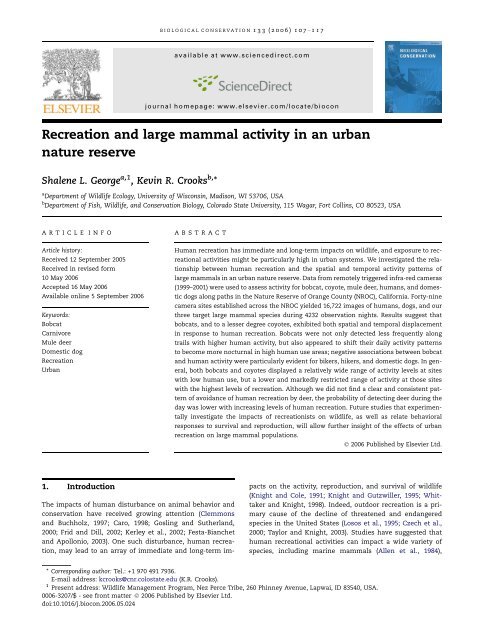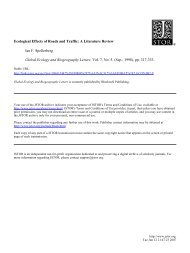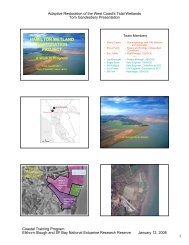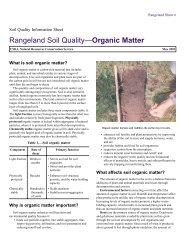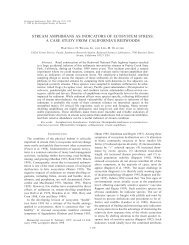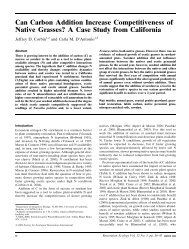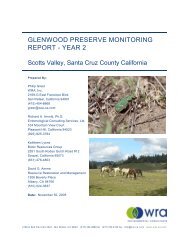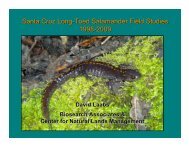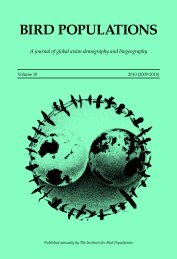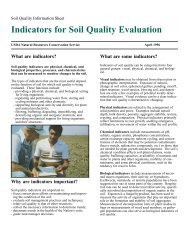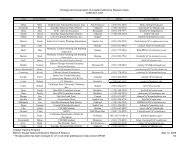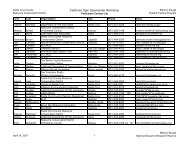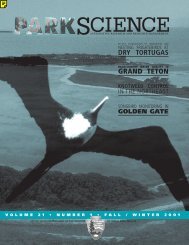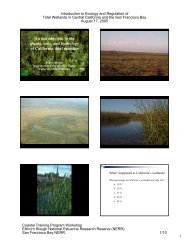Recreation and large mammal activity in an urban nature reserve
Recreation and large mammal activity in an urban nature reserve
Recreation and large mammal activity in an urban nature reserve
Create successful ePaper yourself
Turn your PDF publications into a flip-book with our unique Google optimized e-Paper software.
BIOLOGICAL CONSERVATION 133 (2006) 107– 117available at www.sciencedirect.comjournal homepage: www.elsevier.com/locate/biocon<strong>Recreation</strong> <strong><strong>an</strong>d</strong> <strong>large</strong> <strong>mammal</strong> <strong>activity</strong> <strong>in</strong> <strong>an</strong> urb<strong>an</strong><strong>nature</strong> <strong>reserve</strong>Shalene L. George a,1 , Kev<strong>in</strong> R. Crooks b, *a Department of Wildlife Ecology, University of Wiscons<strong>in</strong>, Madison, WI 53706, USAb Department of Fish, Wildlife, <strong><strong>an</strong>d</strong> Conservation Biology, Colorado State University, 115 Wagar, Fort Coll<strong>in</strong>s, CO 80523, USAARTICLEINFOABSTRACTArticle history:Received 12 September 2005Received <strong>in</strong> revised form10 May 2006Accepted 16 May 2006Available onl<strong>in</strong>e 5 September 2006Keywords:BobcatCarnivoreMule deerDomestic dog<strong>Recreation</strong>Urb<strong>an</strong>Hum<strong>an</strong> recreation has immediate <strong><strong>an</strong>d</strong> long-term impacts on wildlife, <strong><strong>an</strong>d</strong> exposure to recreationalactivities might be particularly high <strong>in</strong> urb<strong>an</strong> systems. We <strong>in</strong>vestigated the relationshipbetween hum<strong>an</strong> recreation <strong><strong>an</strong>d</strong> the spatial <strong><strong>an</strong>d</strong> temporal <strong>activity</strong> patterns of<strong>large</strong> <strong>mammal</strong>s <strong>in</strong> <strong>an</strong> urb<strong>an</strong> <strong>nature</strong> <strong>reserve</strong>. Data from remotely triggered <strong>in</strong>fra-red cameras(1999–2001) were used to assess <strong>activity</strong> for bobcat, coyote, mule deer, hum<strong>an</strong>s, <strong><strong>an</strong>d</strong> domesticdogs along paths <strong>in</strong> the Nature Reserve of Or<strong>an</strong>ge County (NROC), California. Forty-n<strong>in</strong>ecamera sites established across the NROC yielded 16,722 images of hum<strong>an</strong>s, dogs, <strong><strong>an</strong>d</strong> ourthree target <strong>large</strong> <strong>mammal</strong> species dur<strong>in</strong>g 4232 observation nights. Results suggest thatbobcats, <strong><strong>an</strong>d</strong> to a lesser degree coyotes, exhibited both spatial <strong><strong>an</strong>d</strong> temporal displacement<strong>in</strong> response to hum<strong>an</strong> recreation. Bobcats were not only detected less frequently alongtrails with higher hum<strong>an</strong> <strong>activity</strong>, but also appeared to shift their daily <strong>activity</strong> patternsto become more nocturnal <strong>in</strong> high hum<strong>an</strong> use areas; negative associations between bobcat<strong><strong>an</strong>d</strong> hum<strong>an</strong> <strong>activity</strong> were particularly evident for bikers, hikers, <strong><strong>an</strong>d</strong> domestic dogs. In general,both bobcats <strong><strong>an</strong>d</strong> coyotes displayed a relatively wide r<strong>an</strong>ge of <strong>activity</strong> levels at siteswith low hum<strong>an</strong> use, but a lower <strong><strong>an</strong>d</strong> markedly restricted r<strong>an</strong>ge of <strong>activity</strong> at those siteswith the highest levels of recreation. Although we did not f<strong>in</strong>d a clear <strong><strong>an</strong>d</strong> consistent patternof avoid<strong>an</strong>ce of hum<strong>an</strong> recreation by deer, the probability of detect<strong>in</strong>g deer dur<strong>in</strong>g theday was lower with <strong>in</strong>creas<strong>in</strong>g levels of hum<strong>an</strong> recreation. Future studies that experimentally<strong>in</strong>vestigate the impacts of recreationists on wildlife, as well as relate behavioralresponses to survival <strong><strong>an</strong>d</strong> reproduction, will allow further <strong>in</strong>sight of the effects of urb<strong>an</strong>recreation on <strong>large</strong> <strong>mammal</strong> populations.Ó 2006 Published by Elsevier Ltd.1. IntroductionThe impacts of hum<strong>an</strong> disturb<strong>an</strong>ce on <strong>an</strong>imal behavior <strong><strong>an</strong>d</strong>conservation have received grow<strong>in</strong>g attention (Clemmons<strong><strong>an</strong>d</strong> Buchholz, 1997; Caro, 1998; Gosl<strong>in</strong>g <strong><strong>an</strong>d</strong> Sutherl<strong><strong>an</strong>d</strong>,2000; Frid <strong><strong>an</strong>d</strong> Dill, 2002; Kerley et al., 2002; Festa-Bi<strong>an</strong>chet<strong><strong>an</strong>d</strong> Apollonio, 2003). One such disturb<strong>an</strong>ce, hum<strong>an</strong> recreation,may lead to <strong>an</strong> array of immediate <strong><strong>an</strong>d</strong> long-term impactson the <strong>activity</strong>, reproduction, <strong><strong>an</strong>d</strong> survival of wildlife(Knight <strong><strong>an</strong>d</strong> Cole, 1991; Knight <strong><strong>an</strong>d</strong> Gutzwiller, 1995; Whittaker<strong><strong>an</strong>d</strong> Knight, 1998). Indeed, outdoor recreation is a primarycause of the decl<strong>in</strong>e of threatened <strong><strong>an</strong>d</strong> end<strong>an</strong>geredspecies <strong>in</strong> the United States (Losos et al., 1995; Czech et al.,2000; Taylor <strong><strong>an</strong>d</strong> Knight, 2003). Studies have suggested thathum<strong>an</strong> recreational activities c<strong>an</strong> impact a wide variety ofspecies, <strong>in</strong>clud<strong>in</strong>g mar<strong>in</strong>e <strong>mammal</strong>s (Allen et al., 1984),* Correspond<strong>in</strong>g author: Tel.: +1 970 491 7936.E-mail address: kcrooks@cnr.colostate.edu (K.R. Crooks).1 Present address: Wildlife M<strong>an</strong>agement Program, Nez Perce Tribe, 260 Ph<strong>in</strong>ney Avenue, Lapwai, ID 83540, USA.0006-3207/$ - see front matter Ó 2006 Published by Elsevier Ltd.doi:10.1016/j.biocon.2006.05.024
108 BIOLOGICAL CONSERVATION 133 (2006) 107– 117rodents (Ma<strong>in</strong><strong>in</strong>i et al., 1993; Magle et al., 2005), birds (Yalden<strong><strong>an</strong>d</strong> Yalden, 1990; Miller et al., 1998; Stalmaster <strong><strong>an</strong>d</strong> Kaiser,1998; Fernández-Juricic et al., 2005), herpetiles (Hecnar <strong><strong>an</strong>d</strong>M’Closkey, 1998; Lacy <strong><strong>an</strong>d</strong> Mart<strong>in</strong>s, 2003; Rodríquez-Prieto<strong><strong>an</strong>d</strong> Fernández-Juricic, 2005), <strong><strong>an</strong>d</strong> coral (Zakai <strong><strong>an</strong>d</strong> Chadwick-Furm<strong>an</strong>,2002).Mammali<strong>an</strong> carnivores, given their low population densities,<strong>large</strong> area requirements, <strong><strong>an</strong>d</strong> historical <strong><strong>an</strong>d</strong> current persecution,may be especially sensitive to <strong>an</strong>thropogenicdisturb<strong>an</strong>ces (Terborgh, 1974; Pimm et al., 1988; Breitenmoser,1998; Woodroffe <strong><strong>an</strong>d</strong> G<strong>in</strong>sberg, 1998; Woodroffe, 2000; Crooks,2002; Gittlem<strong>an</strong> et al., 2001; Ray et al., 2005), <strong><strong>an</strong>d</strong> prior studieshave suggested hum<strong>an</strong> recreation c<strong>an</strong> alter carnivore behavior<strong><strong>an</strong>d</strong> distribution (e.g. Aaris-Sorensen, 1987; Olson et al.,1997; White et al., 1999; Nev<strong>in</strong> <strong><strong>an</strong>d</strong> Gilbert, 2005a,b). Likewise,hum<strong>an</strong> recreation c<strong>an</strong> also disturb ungulates, <strong>in</strong>itiat<strong>in</strong>g alert<strong><strong>an</strong>d</strong> flush responses <strong><strong>an</strong>d</strong> potentially result<strong>in</strong>g <strong>in</strong> decreasedforag<strong>in</strong>g or reproduction, <strong>in</strong>creased energetic costs or stress,<strong><strong>an</strong>d</strong> avoid<strong>an</strong>ce of recreational areas (Eckste<strong>in</strong> et al., 1979;MacArthur et al., 1982; Freddy et al., 1986; Yarmoloy et al.,1988; Papouchis et al., 2001; Miller et al., 2001; Taylor <strong><strong>an</strong>d</strong>Knight, 2003). Although most studies of recreational impactson <strong>large</strong> <strong>mammal</strong> <strong>activity</strong> have occurred <strong>in</strong> relatively naturalsett<strong>in</strong>gs, wildlife <strong>in</strong> urb<strong>an</strong> systems may be exposed to particularlyhigh levels of hum<strong>an</strong> recreation. The consequences of<strong>in</strong>creased exposure to recreation, however, rema<strong>in</strong> unclear,<strong>in</strong> that wildlife may become desensitized to recurrent hum<strong><strong>an</strong>d</strong>isturb<strong>an</strong>ces <strong>in</strong> some situations but not others, <strong><strong>an</strong>d</strong> suchhabituation may have both beneficial <strong><strong>an</strong>d</strong> negative impacts(Knight <strong><strong>an</strong>d</strong> Gutzwiller, 1995; Whittaker <strong><strong>an</strong>d</strong> Knight, 1998;Taylor <strong><strong>an</strong>d</strong> Knight, 2003; Kloppers et al., 2005; Magle et al.,2005; Smith et al., 2005).Highly urb<strong>an</strong> regions are often characterized by rapidexp<strong>an</strong>sion, which leads to habitat loss <strong><strong>an</strong>d</strong> fragmentation,the primary threat to end<strong>an</strong>gered species <strong>in</strong> the UnitedStates (Wilcove et al., 1998). Widespread urb<strong>an</strong>ization, <strong>in</strong>comb<strong>in</strong>ation with high levels of species endemism <strong><strong>an</strong>d</strong>diversity, has created a major ‘hot-spot’ of ext<strong>in</strong>ction <strong>in</strong>coastal southern Californi<strong>an</strong> natural communities (Myers,1990; Dobson et al., 1997). Or<strong>an</strong>ge County, California, is onesuch coastal region to experience massive hum<strong>an</strong> populationgrowth. Between 1950 <strong><strong>an</strong>d</strong> 1990, Or<strong>an</strong>ge County’s population<strong>in</strong>creased 10-fold, from approximately 200,000 to over2,400,000 (State of California, 2001), with a projected populationof nearly 3.2 million <strong>in</strong> 2010 (State of California, 2004).In response to urb<strong>an</strong> sprawl <strong><strong>an</strong>d</strong> result<strong>an</strong>t habitat fragmentation,The Nature Reserve of Or<strong>an</strong>ge County (NROC) wascreated to p<strong>reserve</strong> some of the region’s last rema<strong>in</strong><strong>in</strong>g naturalareas. Although the NROC protects over 150 km 2 of openspace, hous<strong>in</strong>g <strong><strong>an</strong>d</strong> commercial units encircle <strong><strong>an</strong>d</strong> fragmentthe <strong>reserve</strong>, <strong><strong>an</strong>d</strong> development is cont<strong>in</strong>u<strong>in</strong>g. The NROC ispermeated by foot <strong><strong>an</strong>d</strong> bike trails, ma<strong>in</strong>ta<strong>in</strong>ed dirt roads,<strong><strong>an</strong>d</strong> dry creek beds, which c<strong>an</strong> serve, <strong>in</strong> vary<strong>in</strong>g degrees, asmovement routes for local wildlife as well as hum<strong>an</strong> recreationists,such as hikers, bicyclists, horseback riders, <strong><strong>an</strong>d</strong> dogwalkers.The goal of this study was to <strong>in</strong>vestigate the relationshipbetween <strong>large</strong> <strong>mammal</strong> <strong>activity</strong> patterns <strong><strong>an</strong>d</strong> hum<strong>an</strong> recreation<strong>in</strong> <strong>an</strong> urb<strong>an</strong> <strong>nature</strong> <strong>reserve</strong>. We assessed the spatial<strong><strong>an</strong>d</strong> temporal <strong>activity</strong> patterns of bobcat (Lynx rufus), coyote(C<strong>an</strong>is latr<strong>an</strong>s), <strong><strong>an</strong>d</strong> mule deer (Odocoileus hemionus), as wellas hum<strong>an</strong>s <strong><strong>an</strong>d</strong> domestic dogs, us<strong>in</strong>g <strong>in</strong>fra-red remotely triggeredcameras, valuable survey tools because they c<strong>an</strong> recorddaily <strong>activity</strong> patterns for <strong>an</strong> extended period of time withm<strong>in</strong>imal supervision (Carthew <strong><strong>an</strong>d</strong> Slater, 1991; Cutler <strong><strong>an</strong>d</strong>Sw<strong>an</strong>n, 1999; Carbone et al., 2001). We hypothesized that <strong>in</strong>areas of higher hum<strong>an</strong> recreation, <strong>large</strong> <strong>mammal</strong>s would exhibitlower trail use, particularly dur<strong>in</strong>g the daytime when hum<strong>an</strong>recreationists are most active.2. Methods2.1. Study areaThe NROC is a <strong>reserve</strong> system sp<strong>an</strong>n<strong>in</strong>g the central portion ofOr<strong>an</strong>ge County, California. Hum<strong>an</strong> recreation <strong>in</strong> the <strong>reserve</strong>varies due to differ<strong>in</strong>g restrictions. M<strong>an</strong>y parcels allow recreationon a daily basis <strong><strong>an</strong>d</strong> often year-round. Hum<strong>an</strong> recreation<strong>activity</strong> is consistently high <strong>in</strong> these areas, boththroughout the daytime hours <strong><strong>an</strong>d</strong> throughout the year. Otherparcels are limited to docent-led tours (e.g. l<strong><strong>an</strong>d</strong>s m<strong>an</strong>aged byThe Nature Conserv<strong>an</strong>cy) or completely closed to the generalpublic. These areas typically receive relatively low levels ofhum<strong>an</strong> <strong>activity</strong> throughout the year, although trespass<strong>in</strong>gdoes occur. Much of the NROC, <strong>in</strong>clud<strong>in</strong>g areas with both high<strong><strong>an</strong>d</strong> low levels of hum<strong>an</strong> recreation, supports native habitat<strong><strong>an</strong>d</strong> wildlife communities.The <strong>reserve</strong> is divided <strong>in</strong>to two core areas: the coastal subregion(ca. 73 km 2 ) <strong><strong>an</strong>d</strong> the central sub-region (ca. 77 km 2 ).The coastal sub-region is bordered by the Pacific Oce<strong>an</strong> tothe southwest <strong><strong>an</strong>d</strong> by cities <strong>in</strong> all other directions. The centralsub-region is located at the northwestern term<strong>in</strong>al portion ofthe S<strong>an</strong>ta Ana Mounta<strong>in</strong> r<strong>an</strong>ge. It is connected to the Clevel<strong><strong>an</strong>d</strong>National Forest to the east <strong><strong>an</strong>d</strong> bordered by cities <strong>in</strong> allother directions. The city of Irv<strong>in</strong>e <strong><strong>an</strong>d</strong> major freeway systemsseparate the two sub-regions <strong><strong>an</strong>d</strong>, at present, there are few tono viable habitat corridors for <strong>large</strong> <strong>mammal</strong>s connect<strong>in</strong>g thetwo portions of the <strong>reserve</strong>.Coastal southern California has a Mediterr<strong>an</strong>e<strong>an</strong> type climatewith <strong>an</strong> average <strong>an</strong>nual precipitation level of less th<strong>an</strong>38 cm per year <strong><strong>an</strong>d</strong> two seasons: dry (June–November) <strong><strong>an</strong>d</strong>wet (December–May). The majority of our <strong>large</strong> <strong>mammal</strong> surveys(86% of sampl<strong>in</strong>g effort) occurred <strong>in</strong> the dry season,although some sampl<strong>in</strong>g at some sites cont<strong>in</strong>ued <strong>in</strong>to theearly wet season. Coastal sage scrub, chaparral, <strong><strong>an</strong>d</strong> oakwoodl<strong><strong>an</strong>d</strong>s are the dom<strong>in</strong><strong>an</strong>t habitat types with<strong>in</strong> the NROC,although open grassl<strong><strong>an</strong>d</strong>s <strong><strong>an</strong>d</strong> ripari<strong>an</strong> habitat also exist. Percentcover of native <strong><strong>an</strong>d</strong> exotic pl<strong>an</strong>t species was estimatedwith<strong>in</strong> a 20-m radius of each sampl<strong>in</strong>g station by follow<strong>in</strong>ga modified Braun-Bl<strong>an</strong>quet categorical scale (Kent <strong><strong>an</strong>d</strong> Coker,1992). The cover scale was 0 (absent), 1 (
BIOLOGICAL CONSERVATION 133 (2006) 107– 117 109of wildlife <strong><strong>an</strong>d</strong> hum<strong>an</strong>s <strong>in</strong> order to determ<strong>in</strong>e their spatial <strong><strong>an</strong>d</strong>temporal <strong>activity</strong> patterns. We focused our <strong>an</strong>alyses on three<strong>large</strong> <strong>mammal</strong>s – bobcat, coyote, <strong><strong>an</strong>d</strong> mule deer – that occurredthroughout the Nature Reserve of Or<strong>an</strong>ge County <strong><strong>an</strong>d</strong>were potentially responsive to hum<strong>an</strong> disturb<strong>an</strong>ces.Forty-n<strong>in</strong>e camera sites were established along dirt roads<strong><strong>an</strong>d</strong> major game trails throughout the NROC, with each siteseparated by a m<strong>in</strong>imum of 750 m. Camera locations wererestricted to relatively concealed areas to reduce theft <strong><strong>an</strong>d</strong>v<strong><strong>an</strong>d</strong>alism. In regions considered high risk for theft, cameraswere placed <strong>in</strong> lock<strong>in</strong>g steel conta<strong>in</strong>ers attached to metalposts. In low risk areas, cameras were attached to <strong>an</strong><strong>an</strong>chor (tree, post, etc.), <strong><strong>an</strong>d</strong> secured to the <strong>an</strong>chor by acable <strong><strong>an</strong>d</strong> lock. Cameras were set to delay 3 m<strong>in</strong> betweensuccessive photographs, were equipped with a 35 mmauto-focus<strong>in</strong>g lens <strong><strong>an</strong>d</strong> <strong>an</strong> auto flash mech<strong>an</strong>ism, <strong><strong>an</strong>d</strong> haveshoot<strong>in</strong>g dist<strong>an</strong>ces of 0.35–6.00 m. Date <strong><strong>an</strong>d</strong> time (PacificSt<strong><strong>an</strong>d</strong>ard Time, PST) of photographs were automaticallyburned onto the negatives. Infrared sensors have a maximumdetection dist<strong>an</strong>ce of 18.3 m, with <strong>an</strong> optimal dist<strong>an</strong>ceof 0.3–9.1 m. Each camera was set for cont<strong>in</strong>uous actionthroughout the day <strong><strong>an</strong>d</strong> night, <strong><strong>an</strong>d</strong> was positioned fac<strong>in</strong>gthe road or trail to ensure documentation of associatedwildlife <strong><strong>an</strong>d</strong> hum<strong>an</strong> recreational <strong>activity</strong>. Data collection beg<strong>an</strong><strong>in</strong> June <strong><strong>an</strong>d</strong> ended no later th<strong>an</strong> February from 1999 to2001, <strong><strong>an</strong>d</strong> cameras were checked once per calendar weekunless site <strong>activity</strong> required them to be checked more frequently(shortest <strong>in</strong>terval was once per day). Each year acamera rema<strong>in</strong>ed at a site for <strong>an</strong> average of 53.6 nights(SD = 19.9, r<strong>an</strong>ge: 21–114 nights).An <strong>in</strong>dex of relative <strong>activity</strong> (RA) was estimated for eachcamera station by calculat<strong>in</strong>g the number of images of aspecies detected <strong>in</strong> a photograph divided by the numberof nights the camera operated at that station. We used RAas measure of the spatial displacement of wildlife species<strong>in</strong> response to hum<strong>an</strong> recreationists across the 49 camerastations. Although we did not <strong>in</strong>dividually identify <strong>an</strong>imals<strong>in</strong> photographs <strong><strong>an</strong>d</strong> thus c<strong>an</strong>not measure absolute densities,the camera <strong>in</strong>dex c<strong>an</strong> provide a useful measure ofthe relative <strong>activity</strong> of species at each sampl<strong>in</strong>g po<strong>in</strong>t (Cutler<strong><strong>an</strong>d</strong> Sw<strong>an</strong>n, 1999; Carbone et al., 2001). If multiple <strong>in</strong>dividuals(images) were captured with<strong>in</strong> a s<strong>in</strong>gle photograph,each <strong>in</strong>dividual (image) was counted s<strong>in</strong>gularly. Relative<strong>activity</strong> <strong>in</strong>dices for wildlife species conformed to theassumption of a normal distribution, whereas hum<strong>an</strong> <strong>in</strong>dicesdid not <strong><strong>an</strong>d</strong> thus were log tr<strong>an</strong>sformed <strong>in</strong> subsequent<strong>an</strong>alyses.2.3. Temporal displacement (percent daytime <strong>activity</strong>)For each target species detected, percent daytime <strong>activity</strong>(PDA) was calculated by collaps<strong>in</strong>g images taken 0600–1759(PST) <strong>in</strong>to a diurnal category <strong><strong>an</strong>d</strong> images taken 1800–0559(PST) <strong>in</strong>to a nocturnal category. This allowed for <strong>an</strong> overallestimation of PDA per species <strong><strong>an</strong>d</strong> at each site. PDA was calculatedper species only for sites with a m<strong>in</strong>imum of fiveimages. We used PDA as a measure of the temporal displacementof wildlife to hum<strong>an</strong> recreationists. The proportion ofdaytime <strong>activity</strong> was arcs<strong>in</strong> square root tr<strong>an</strong>sformed for statistical<strong>an</strong>alyses.2.4. Data <strong>an</strong>alysis2.4.1. Sub-region, season, vegetationPrelim<strong>in</strong>ary <strong>an</strong>alyses were conducted to evaluate the potentialeffects of sub-region (coastal <strong><strong>an</strong>d</strong> central <strong>reserve</strong>), season(wet <strong><strong>an</strong>d</strong> dry), <strong><strong>an</strong>d</strong> vegetative cover (trees, native shrubs, <strong><strong>an</strong>d</strong>exotic vegetation) on relative <strong>activity</strong> <strong><strong>an</strong>d</strong> circadi<strong>an</strong> <strong>activity</strong> ofwildlife <strong><strong>an</strong>d</strong> hum<strong>an</strong>s. Relative <strong>activity</strong> did not differ betweensub-regions for bobcats, mule deer, <strong><strong>an</strong>d</strong> hum<strong>an</strong>s (all t < 0.613,all P > 0.543), although RA was higher <strong>in</strong> the coastal subregionfor coyotes (me<strong>an</strong> coastal ± SD = 0.276 ± 0.234, n = 24;me<strong>an</strong> central = 0.160 ± 0.124, n = 20; t = 2.097, P = 0.043). PDAfor mule deer did not signific<strong>an</strong>tly differ between sub-regions(me<strong>an</strong> coastal = 0.412 ± 0.410, n = 16; me<strong>an</strong> central = 0.679 ±0.492, n = 16; t = 1.699, P = 0.105), however, PDA was higher <strong>in</strong>the coastal sub-region for bobcats (me<strong>an</strong> coastal= 0.731 ± 0.231, n = 11; me<strong>an</strong> central = 0.420 ± 0.278, n = 13;t = 2.945, P = 0.007) <strong><strong>an</strong>d</strong> coyotes (me<strong>an</strong> coastal = 0.500 ± 0.246,n = 19; me<strong>an</strong> central = 0.264 ± 0.233, n = 17; t = 2.950, P =0.006). To account for sub-regional effects <strong>in</strong> subsequent statistical<strong>an</strong>alyses of hum<strong>an</strong> recreational impacts, RA for coyotes<strong><strong>an</strong>d</strong> PDA for both coyotes <strong><strong>an</strong>d</strong> bobcats werest<strong><strong>an</strong>d</strong>ardized by tak<strong>in</strong>g the st<strong><strong>an</strong>d</strong>ard normal Z scores with<strong>in</strong>each sub-region.Although log tr<strong>an</strong>sformed hum<strong>an</strong> RA <strong>in</strong>dices tended to behigher <strong>in</strong> the dry season (me<strong>an</strong> dry = 0.385 ± 1.022, me<strong>an</strong>wet = 0.011 ± 1.245, n = 14 sites sampled <strong>in</strong> both the wet<strong><strong>an</strong>d</strong> dry season with<strong>in</strong> the same year; paired t = 2.085,P = 0.057), RA did not differ by season for bobcats, coyotes<strong><strong>an</strong>d</strong> mule deer (all paired t < 1.164, all P > 0.275) nor did PDAdiffer by season for these three target species (all pairedt < 1.154, all P > 0.292) <strong><strong>an</strong>d</strong> the majority (86%) of sampl<strong>in</strong>g occurreddur<strong>in</strong>g the dry season. Thus, season was not <strong>in</strong>cluded<strong>in</strong> further <strong>an</strong>alyses. Likewise, vegetative cover of trees, nativeshrubs <strong><strong>an</strong>d</strong> exotic vegetation did not differ between sub-regions(all t < 1.770, P > 0.083, n coastal = 24, n central = 24) orbetween areas of high <strong><strong>an</strong>d</strong> low hum<strong>an</strong> use (all t < 0.731,P > 0.473, n high = 14, n low = 34; see below for def<strong>in</strong>ition ofhigh <strong><strong>an</strong>d</strong> low hum<strong>an</strong> use sites). Further, prelim<strong>in</strong>ary tests revealedfew signific<strong>an</strong>t relationships between vegetative cover<strong><strong>an</strong>d</strong> RA or PDA of wildlife (George, unpublished data). Thus,vegetative cover was also not <strong>in</strong>cluded <strong>in</strong> further <strong>an</strong>alyses.2.4.2. Hum<strong>an</strong> recreationThe relationships between recreation <strong><strong>an</strong>d</strong> wildlife <strong>activity</strong>were assessed <strong>in</strong> multiple steps. First, logistic regressionswere performed to determ<strong>in</strong>e if overall hum<strong>an</strong> <strong>activity</strong> wasa signific<strong>an</strong>t predictor of the probability of a species us<strong>in</strong>g amonitored trail (for all 49 camera stations) as well as the probabilityof exhibit<strong>in</strong>g daytime <strong>activity</strong> at a site (for all stationswith a m<strong>in</strong>imum of five images for each species). For the logisticregression models, the response variable was <strong>in</strong>put asa 1 (or 0) if a species was detected (or not) at a camera stationor dur<strong>in</strong>g the day.Second, each camera site was categorized as either ‘‘high’’or ‘‘low’’ based on overall levels of hum<strong>an</strong> recreation. A visual<strong>in</strong>spection of the hum<strong>an</strong> RA distribution <strong>in</strong>dicated a naturalbreak at a camera <strong>in</strong>dex of about 4.0 (i.e. four images of recreationistsper sampl<strong>in</strong>g day), correspond<strong>in</strong>g to approximately30% of the most highly used sites by recreationists. This
110 BIOLOGICAL CONSERVATION 133 (2006) 107– 117division resulted <strong>in</strong> 14 ‘‘high’’ (4.2–39.1 recreationists per sampl<strong>in</strong>gday) <strong><strong>an</strong>d</strong> 35 ‘‘low’’ (0.2–2.9 recreationists per day) hum<strong>an</strong>use sites. T-tests were used to <strong>in</strong>vestigate the differences <strong>in</strong>species RA <strong><strong>an</strong>d</strong> PDA <strong>in</strong> areas of high versus low hum<strong>an</strong> use.Third, we developed regression models with wildlife RA orPDA as the response variable <strong><strong>an</strong>d</strong> overall hum<strong>an</strong> <strong>activity</strong> asthe predictor variable. Four c<strong><strong>an</strong>d</strong>idate models were compared:(1) Null: <strong>an</strong> <strong>in</strong>tercept only model where hum<strong>an</strong> <strong>activity</strong> wasnot considered; (2) Log Hum<strong>an</strong>: represent<strong>in</strong>g a l<strong>in</strong>ear, 1st orderrelationship between hum<strong>an</strong> <strong><strong>an</strong>d</strong> wildlife <strong>activity</strong>; (3)(Log Hum<strong>an</strong>) 2 : represent<strong>in</strong>g a non-l<strong>in</strong>ear relationship betweenhum<strong>an</strong> <strong><strong>an</strong>d</strong> wildlife <strong>activity</strong>; <strong><strong>an</strong>d</strong> (4) Log Hum<strong>an</strong> Polynomial:a global model represent<strong>in</strong>g a non-l<strong>in</strong>ear 2nd orderpolynomial <strong>in</strong>corporat<strong>in</strong>g both (Log Hum<strong>an</strong>) <strong><strong>an</strong>d</strong> (Log Hum<strong>an</strong>)2 . Akaike’s Information Criterion (AIC) was used formodel selection; the model with the m<strong>in</strong>imum AIC was consideredthe best approximat<strong>in</strong>g model <strong><strong>an</strong>d</strong> models with<strong>in</strong> twoAIC units of the m<strong>in</strong>imum AIC model were considered competitivemodels with some support from the data (Burnham<strong><strong>an</strong>d</strong> Anderson, 2002).F<strong>in</strong>ally, to further explore the relationship between wildlife<strong>activity</strong> <strong><strong>an</strong>d</strong> various types of hum<strong>an</strong> recreation, we also constructedl<strong>in</strong>ear regression models of <strong>large</strong> <strong>mammal</strong> relative<strong>activity</strong> <strong><strong>an</strong>d</strong> circadi<strong>an</strong> <strong>activity</strong> us<strong>in</strong>g specific recreational categoriesas predictor variables: overall hum<strong>an</strong> <strong>activity</strong>, hikers(<strong>in</strong>clud<strong>in</strong>g joggers), bicyclists, equestri<strong>an</strong>s, <strong><strong>an</strong>d</strong> motorizedvehicles (<strong>in</strong>clud<strong>in</strong>g automobiles, motorbikes, <strong><strong>an</strong>d</strong> all-terra<strong>in</strong>vehicles). Because domestic dogs were highly correlated tohum<strong>an</strong> visitations (George, unpublished data), we also <strong>an</strong>alyzeddog visitations, exclusive of <strong>an</strong>y other recreational category,as a predictor variable of <strong>large</strong> <strong>mammal</strong> <strong>activity</strong>.Camera <strong>in</strong>dices for all recreational categories were log-tr<strong>an</strong>sformedfor statistical <strong>an</strong>alyses.3. Results3.1. Spatial displacementFrom 1999 to 2001, cameras stationed across 49 sites operatedfor a total of 4232 camera nights, yield<strong>in</strong>g 16,722 images of hum<strong>an</strong>s,domestic dogs, <strong><strong>an</strong>d</strong> our three target <strong>large</strong> <strong>mammal</strong> species(Table 1). Coyotes were the most frequently detected <strong>large</strong><strong>mammal</strong>, followed closely by mule deer, <strong><strong>an</strong>d</strong> then bobcats(Table 1); all three species were detected at most camera stations<strong>in</strong> the NROC. Hum<strong>an</strong>s were the most detected speciesoverall, occurr<strong>in</strong>g throughout the <strong>reserve</strong>. Hikers were themost common recreational category, followed by bikers, vehicles,<strong><strong>an</strong>d</strong> equestri<strong>an</strong>s. Domestic dogs also were frequentlydetected.Logistic regression models <strong>in</strong>dicated that the probability ofdetection at a camera station was negatively related to hum<strong>an</strong><strong>activity</strong> for bobcats (coefficient = 0.584, v 2 = 6.459,P = 0.011). The probability of detection at a camera stationwas not signific<strong>an</strong>tly related to hum<strong>an</strong> <strong>activity</strong> for coyote(coefficient = 0.471, v 2 = 2.344, P = 0.126) <strong><strong>an</strong>d</strong> mule deer (coefficient= 0.139, v 2 = 0.287, P = 0.592).When compar<strong>in</strong>g high versus low hum<strong>an</strong> use sites, RA<strong>in</strong>dices were signific<strong>an</strong>tly lower <strong>in</strong> areas of high overall hum<strong>an</strong>use for bobcats (me<strong>an</strong> high = 0.061 ± 0.036, n = 8; me<strong>an</strong>low = 0.143 ± 0.103, n = 29; t = 2.192, P = 0.035) <strong><strong>an</strong>d</strong> coyotes(st<strong><strong>an</strong>d</strong>ardized me<strong>an</strong> high = 0.454 ± 0.293, n = 11; st<strong><strong>an</strong>d</strong>ardizedme<strong>an</strong> low = 0.302 ± 1.059, n = 33; t = 2.322, P = 0.025). Muledeer RA <strong>in</strong>dices did not differ between areas of high <strong><strong>an</strong>d</strong> lowhum<strong>an</strong> use (me<strong>an</strong> high = 0.218 ± 0.211, n = 11; me<strong>an</strong>low = 0.186 ± 0.267, n = 29; t = 0.370, P = 0.713).Across all 49 sampl<strong>in</strong>g stations, the negative non-l<strong>in</strong>earmodel [‘‘(Log Hum<strong>an</strong>) 2 ’’] between bobcat RA <strong><strong>an</strong>d</strong> overall hum<strong>an</strong><strong>activity</strong> had the strongest support from the data, witha model weight of 0.456; the l<strong>in</strong>ear model (‘‘Log Hum<strong>an</strong>’’)was also competitive (Table 2). The null model was supportedby the data for coyotes <strong><strong>an</strong>d</strong> mule deer with no other compet<strong>in</strong>gmodels. When viewed graphically, negative relationshipsbetween overall hum<strong>an</strong> recreation <strong><strong>an</strong>d</strong> bobcat <strong><strong>an</strong>d</strong> coyote<strong>activity</strong> were similar <strong>in</strong> appear<strong>an</strong>ce (Fig. 1). Both species demonstrateda wide r<strong>an</strong>ge of <strong>activity</strong> levels at sites with lowerhum<strong>an</strong> use, from zero relative <strong>activity</strong> to the highest RA <strong>in</strong>dexrecorded for each species. In contrast, bobcats <strong><strong>an</strong>d</strong> coyotesdisplayed a lower <strong><strong>an</strong>d</strong> markedly restricted r<strong>an</strong>ge of <strong>activity</strong><strong>in</strong> those sites with the highest levels of hum<strong>an</strong> recreation.When <strong>an</strong>alyz<strong>in</strong>g specific recreational categories at all 49camera stations, bobcat RA was negatively related to the<strong>activity</strong> of all hum<strong>an</strong>s, bikers, <strong><strong>an</strong>d</strong> hikers, but not equestri<strong>an</strong>s,Table 1 – Camera station visits from 1999 to 2001 dur<strong>in</strong>g 4232 camera observation nights across 49 sites <strong>in</strong> the NatureReserve of Or<strong>an</strong>ge County, CaliforniaSpecies Number of images Number of observed sites Me<strong>an</strong> relative <strong>activity</strong> (SE) Overall % daytime <strong>activity</strong>Coyote 874 44 0.200 (0.029) 23.16Mule deer 813 41 0.164 (0.034) 25.19Bobcat 458 37 0.095 (0.014) 31.83All hum<strong>an</strong>s 14,101 49 5.257 (1.345) 94.43Hikers 8217 49 3.004 (0.877) 92.72Bikers 3562 34 1.725 (0.671) 98.00Vehicles 1758 42 0.407 (0.091) 95.17Equestri<strong>an</strong>s 564 21 0.122 (0.036) 94.25Domestic dog 476 30 0.169 (0.065) 83.37Images are the count of <strong>in</strong>dividuals captured <strong>in</strong> all photographs dur<strong>in</strong>g the study. Observed sites <strong>in</strong>dicates the number of camera stations <strong>in</strong>which at least one <strong>in</strong>dividual of the species was detected. The me<strong>an</strong> relative <strong>activity</strong> <strong>in</strong>dex (st<strong><strong>an</strong>d</strong>ard error) is derived from all sites <strong><strong>an</strong>d</strong> acrossall years. Overall percent daytime <strong>activity</strong> represents the proportion of a species images recorded between the hours of 0600–1759 (PST) acrossall sites <strong><strong>an</strong>d</strong> all years.
BIOLOGICAL CONSERVATION 133 (2006) 107– 117 111Table 2 – AIC results for species relative <strong>activity</strong> <strong>in</strong>dices across all 49 sitesSpecies Model log(Lhood) K D i AIC c W iBobcat (Log Hum<strong>an</strong>) 2 115.897 3 0 0.456Log Hum<strong>an</strong> 115.594 3 0.607 0.337Log Hum<strong>an</strong> + (Log Hum<strong>an</strong>) 2 116.061 4 2.425 0.136Null 112.768 2 3.714 0.071Coyote a Null 4.367 2 0 0.870Log Hum<strong>an</strong> 3.100 3 5.078 0.069(Log Hum<strong>an</strong>) 2 2.647 3 5.984 0.044Log Hum<strong>an</strong> + (Log Hum<strong>an</strong>) 2 3.124 4 7.782 0.018Mule deer Null 70.576 2 0 0.606Log Hum<strong>an</strong> 70.619 3 2.458 0.177(Log Hum<strong>an</strong>) 2 70.578 3 2.541 0.170Log Hum<strong>an</strong> + (Log Hum<strong>an</strong>) 2 70.672 4 5.105 0.047The models exam<strong>in</strong>ed were: (1) Null, <strong>in</strong> which hum<strong>an</strong>s were excluded from <strong>an</strong>alysis; (2) Log Hum<strong>an</strong>, represent<strong>in</strong>g a l<strong>in</strong>ear relationship betweenhum<strong>an</strong>s <strong><strong>an</strong>d</strong> wildlife species; (3) (Log Hum<strong>an</strong>) 2 , which represents a non-l<strong>in</strong>ear relationship between hum<strong>an</strong> <strong><strong>an</strong>d</strong> wildlife <strong>in</strong>dices; <strong><strong>an</strong>d</strong> (4) LogHum<strong>an</strong> + (Log Hum<strong>an</strong>) 2 , a non-l<strong>in</strong>ear 2nd order polynomial model.a St<strong><strong>an</strong>d</strong>ard normal (Z) scores.vehicles, or dogs (Table 3). Similarly, coyote RA was negativelyrelated to overall hum<strong>an</strong> <strong><strong>an</strong>d</strong> hiker <strong>activity</strong>, <strong><strong>an</strong>d</strong> there was atrend for a negative relationship with bikers, but was not relatedto equestri<strong>an</strong>s, vehicles, or dogs. Mule deer RA wasnot related to <strong>an</strong>y recreational group.3.2. Temporal displacementAlmost all hum<strong>an</strong> <strong>activity</strong> was recorded between the hours of0600 <strong><strong>an</strong>d</strong> 1800 (Table 1). Domestic dogs also showed a highPDA (Table 1), reveal<strong>in</strong>g their strong association with hum<strong>an</strong><strong>activity</strong>. Bobcats, coyotes, <strong><strong>an</strong>d</strong> mule deer showed similar degreesof nocturnality, primarily nocturnal with some diurnal<strong>activity</strong> (Table 1).Logistic regression models <strong>in</strong>dicated that the probability ofdaytime <strong>activity</strong> at a camera station was negatively related tohum<strong>an</strong> RA <strong>in</strong>dices for bobcats (coefficient = 1.421, v 2 = 5.352,n = 24, P = 0.021) <strong><strong>an</strong>d</strong> mule deer (coefficient = 0.583,v 2 = 3.879, n = 32, P = 0.049). The probability of detect<strong>in</strong>g coyotesdur<strong>in</strong>g the day was not signific<strong>an</strong>tly related to hum<strong>an</strong><strong>activity</strong> (coefficient = 0.252, v 2 = 0.858, n = 36, P = 0.354).Bobcats tended to have a lower PDA (20.8%) <strong>in</strong> sites withthe highest hum<strong>an</strong> recreation compared to their PDA(33.2%) <strong>in</strong> sites with lower hum<strong>an</strong> <strong>activity</strong> (st<strong><strong>an</strong>d</strong>ardizedme<strong>an</strong> high = 0.337 ± 0.917, n = 3; st<strong><strong>an</strong>d</strong>ardized me<strong>an</strong>low = 0.483 ± 0.716, n = 21; t = 1.803, P = 0.085). The PDA ofmule deer (me<strong>an</strong> high = 0.493 ± 0.646, n = 9; me<strong>an</strong>low = 0.566 ± 0.390, n = 23; t = 0.391, P = 0.699) <strong><strong>an</strong>d</strong> coyotes(st<strong><strong>an</strong>d</strong>ardized me<strong>an</strong> high = 0.236 ± 0.759, n = 7; st<strong><strong>an</strong>d</strong>ardizedme<strong>an</strong> low = 0.109 ± 0.821, n = 29; t = 1.010, P = 0.320) did notdiffer between areas of high <strong><strong>an</strong>d</strong> low hum<strong>an</strong> use.There was a negative l<strong>in</strong>ear relationship between bobcatPDA <strong><strong>an</strong>d</strong> hum<strong>an</strong> RA, with a relatively high model weight(0.642) <strong><strong>an</strong>d</strong> no other compet<strong>in</strong>g models (Table 4). For coyotePDA, the non-l<strong>in</strong>ear model was supported, with both the null<strong><strong>an</strong>d</strong> l<strong>in</strong>ear as competitive models. The null model was them<strong>in</strong>imum AIC model for mule deer PDA, with no other compet<strong>in</strong>gmodels. As with relative <strong>activity</strong>, bobcats <strong><strong>an</strong>d</strong> coyotesexhibited a greater r<strong>an</strong>ge of daytime <strong>activity</strong> <strong>in</strong> areas with lessrecreation <strong><strong>an</strong>d</strong> showed less daytime <strong>activity</strong>, <strong><strong>an</strong>d</strong> a more restrictedr<strong>an</strong>ge of PDA, <strong>in</strong> areas highly used by hum<strong>an</strong>s(Fig. 2a <strong><strong>an</strong>d</strong> b).When <strong>an</strong>alyz<strong>in</strong>g specific recreational categories, the proportionof daytime <strong>activity</strong> for bobcats was negatively relatedto overall hum<strong>an</strong>, biker, hiker, <strong><strong>an</strong>d</strong> dog <strong>activity</strong>, but not equestri<strong>an</strong>s<strong><strong>an</strong>d</strong> vehicles (Table 3). Coyote PDA was not signific<strong>an</strong>tlyrelated to <strong>an</strong>y recreational category, although there was <strong>an</strong>egative trend with dog <strong>activity</strong>. Deer PDA was not relatedto <strong>an</strong>y recreation groups.4. DiscussionBobcats appeared most responsive to recreation <strong>in</strong> the NatureReserve of Or<strong>an</strong>ge County. Bobcats not only were detected lessfrequently along trails with higher hum<strong>an</strong> <strong>activity</strong>, but also appearedto shift their daily <strong>activity</strong> patterns to become morenocturnal <strong>in</strong> high hum<strong>an</strong> use areas, suggest<strong>in</strong>g both spatial<strong><strong>an</strong>d</strong> temporal displacement <strong>in</strong> response to hum<strong>an</strong> recreation.Specifically, we found: (1) the probability of record<strong>in</strong>g bobcatsat camera stations, as well as the probability of detect<strong>in</strong>g themdur<strong>in</strong>g the day, decreased with <strong>in</strong>creas<strong>in</strong>g hum<strong>an</strong> recreation;(2) bobcat camera <strong>in</strong>dices <strong><strong>an</strong>d</strong> proportion of daytime <strong>activity</strong>were relatively low <strong>in</strong> the sites with the highest hum<strong>an</strong> <strong>activity</strong>;<strong><strong>an</strong>d</strong> (3) statistical support for models describ<strong>in</strong>g negativerelationships between recreational <strong>activity</strong> <strong><strong>an</strong>d</strong> bobcat relative<strong>activity</strong> <strong><strong>an</strong>d</strong> proportion of daytime <strong>activity</strong>. Negative associationsbetween bobcat <strong>activity</strong> <strong><strong>an</strong>d</strong> specific recreational categoriessuggested spatial displacement <strong>in</strong> response to bikers <strong><strong>an</strong>d</strong>hikers <strong><strong>an</strong>d</strong> temporal displacement <strong>in</strong> response to bikers, hikers,<strong><strong>an</strong>d</strong> dogs, but no displacement <strong>in</strong> response to equestri<strong>an</strong>sor motorized vehicles. Although to a lesser degree th<strong>an</strong> bobcats,coyotes also appeared to exhibit spatial displacement<strong>in</strong> that coyote <strong>activity</strong> was lower <strong>in</strong> the sites with the most recreation<strong><strong>an</strong>d</strong> was negatively related to overall hum<strong>an</strong>, hiker,<strong><strong>an</strong>d</strong> biker visitations; a trend of temporal displacement <strong>in</strong> responseto dogs also was evident.Previous research also has found that pedestri<strong>an</strong>s, mounta<strong>in</strong>bikers, <strong><strong>an</strong>d</strong> domestic dogs c<strong>an</strong> disturb wildlife, although
112 BIOLOGICAL CONSERVATION 133 (2006) 107– 117(a) 0.500.450.400.35bobcat RA <strong>in</strong>dex0.300.250.200.150.100.050.00-0.05-2 -1 0 1 2 34log hum<strong>an</strong> RA <strong>in</strong>dex(b)3.02.5st<strong><strong>an</strong>d</strong>ardized coyote RA <strong>in</strong>dex2.01.51.00.50.0-0.5-1.0-1.5-2 -1 0 1 2 34log hum<strong>an</strong> RA <strong>in</strong>dexFig. 1 – (a <strong><strong>an</strong>d</strong> b) The relationship between log hum<strong>an</strong> relative <strong>activity</strong> (RA) <strong>in</strong>dices <strong><strong>an</strong>d</strong> RA <strong>in</strong>dices of (a) bobcat <strong><strong>an</strong>d</strong> (b) coyoteacross all 49 camera sampl<strong>in</strong>g sites. Coyote RA represent st<strong><strong>an</strong>d</strong>ard normal Z scores (see text).relatively little is known about their impacts on <strong>mammal</strong>i<strong>an</strong>carnivores. Because wildlife tend to be particularly responsiveto the hum<strong>an</strong> form (Taylor <strong><strong>an</strong>d</strong> Knight, 2003), pedestri<strong>an</strong>s c<strong>an</strong>elicit more <strong>in</strong>tense reactions th<strong>an</strong> motorized vehicles (Eckste<strong>in</strong>et al., 1979; MacArthur et al., 1982; Freddy et al., 1986),especially when accomp<strong>an</strong>ied by domestic dogs (MacArthuret al., 1982; Yalden <strong><strong>an</strong>d</strong> Yalden, 1990; Ma<strong>in</strong><strong>in</strong>i et al., 1993; Milleret al., 2001). Impacts of dogs on native carnivores are not wellunderstood, but may <strong>in</strong>clude disruption of carnivore behaviorthrough chas<strong>in</strong>g, bark<strong>in</strong>g, <strong><strong>an</strong>d</strong> scent mark<strong>in</strong>g via ur<strong>in</strong>e <strong><strong>an</strong>d</strong>scat. In comparison to pedestri<strong>an</strong>s, mounta<strong>in</strong> bikers movequickly <strong><strong>an</strong>d</strong> quietly, <strong><strong>an</strong>d</strong> <strong>in</strong> the NROC also travel off designatedtrails, <strong><strong>an</strong>d</strong> thus may be especially unpredictable <strong><strong>an</strong>d</strong> hencedisruptive to wildlife (MacArthur et al., 1982; Knight <strong><strong>an</strong>d</strong> Gutzwiller,1995; Miller et al., 2001; Taylor <strong><strong>an</strong>d</strong> Knight, 2003). Thedegree of spatial <strong><strong>an</strong>d</strong> temporal displacement of wildlife by differentforms of hum<strong>an</strong> recreation c<strong>an</strong> help guide m<strong>an</strong>agementstrategies to mitigate recreational impacts. For <strong>in</strong>st<strong>an</strong>ce, spatialdisplacement of bobcat <strong><strong>an</strong>d</strong> coyotes by hikers <strong><strong>an</strong>d</strong> bikersmight warr<strong>an</strong>t greater enforcement of exist<strong>in</strong>g off-trail <strong><strong>an</strong>d</strong>
BIOLOGICAL CONSERVATION 133 (2006) 107– 117 113Table 3 – Relationship between wildlife relative <strong>activity</strong> (RA) <strong><strong>an</strong>d</strong> percent daytime <strong>activity</strong> (PDA) <strong><strong>an</strong>d</strong> hum<strong>an</strong> recreationalcategoriesBobcat Coyote Mule deerCoefficient r P Coefficient r P Coefficient r PRA *Overall hum<strong>an</strong> 0.023 0.33 0.021 0.193 0.29 0.047 0.007 0.04 0.775Hiker 0.038 0.34 0.016 0.371 0.34 0.017 0.012 0.05 0.756Biker 0.045 0.36 0.010 0.307 0.26 0.076 0.051 0.18 0.229Vehicles 0.039 0.11 0.433 0.555 0.17 0.250 0.008 0.01 0.947Equestri<strong>an</strong> 0.040 0.07 0.629 0.240 0.04 0.764 0.221 0.17 0.252Dog 0.028 0.07 0.633 0.318 0.08 0.578 0.128 0.14 0.352PDA **Overall hum<strong>an</strong> 0.369 0.50 0.013 0.127 0.22 0.193 0.042 0.13 0.480Hiker 0.618 0.54 0.006 0.243 0.27 0.108 0.108 0.18 0.329Biker 2.367 0.45 0.028 0.229 0.22 0.193 0.021 0.04 0.819Vehicles 0.100 0.03 0.882 0.407 0.16 0.366 0.087 0.05 0.806Equestri<strong>an</strong> 0.485 0.10 0.654 0.354 0.07 0.671 0.749 0.25 0.173Dog 1.574 0.51 0.012 1.078 0.29 0.081 0.129 0.04 0.849*All n = 49.**All n = 24 for bobcats; all n = 36 for coyotes; all n = 32 for mule deer.Table 4 – AIC results for wildlife percent daytime <strong>activity</strong> (PDA)Species Model log(Lhood) K D i AIC c W iBobcat a Log Hum<strong>an</strong> 10.168 3 0 0.642(Log Hum<strong>an</strong>) 2 8.633 3 3.070 0.138Log Hum<strong>an</strong> + (Log Hum<strong>an</strong>) 2 10.370 4 3.406 0.117Null 6.715 2 3.650 0.103Coyote a (Log Hum<strong>an</strong>) 2 9.812 3 0 0.423Null 8.067 2 0.714 0.296Log Hum<strong>an</strong> 8.979 3 1.667 0.184Log Hum<strong>an</strong> + (Log Hum<strong>an</strong>) 2 9.885 4 2.935 0.097Mule deer Null 24.958 2 0 0.614Log Hum<strong>an</strong> 25.228 3 2.347 0.190(Log Hum<strong>an</strong>) 2 25.026 3 2.750 0.155Log Hum<strong>an</strong> + (Log Hum<strong>an</strong>) 2 25.306 4 5.439 0.040Four models were exam<strong>in</strong>ed: (1) Null, <strong>in</strong> which hum<strong>an</strong>s were excluded from <strong>an</strong>alysis; (2) Log Hum<strong>an</strong>, represent<strong>in</strong>g a l<strong>in</strong>ear relationshipbetween hum<strong>an</strong> relative <strong>activity</strong> <strong>in</strong>dices <strong><strong>an</strong>d</strong> wildlife percent daytime <strong>activity</strong>; (3) (Log Hum<strong>an</strong>) 2 , which represents a non-l<strong>in</strong>ear relationshipbetween hum<strong>an</strong> <strong>in</strong>dices <strong><strong>an</strong>d</strong> wildlife percent daytime <strong>activity</strong>; <strong><strong>an</strong>d</strong> (4) Log Hum<strong>an</strong> + (Log Hum<strong>an</strong>) 2 , a non-l<strong>in</strong>ear 2nd order polynomial model.Sites with five images or more were <strong>in</strong>cluded for species PDA <strong>an</strong>alyses (see text).a St<strong><strong>an</strong>d</strong>ard normal (Z) scores.trespass<strong>in</strong>g regulations, or even sett<strong>in</strong>g aside new areas thatrestrict recreation. Alternatively, temporal displacement bydomestic dogs may suggest limit<strong>in</strong>g the hours <strong>in</strong> which a <strong>reserve</strong>is open to dog walk<strong>in</strong>g.Our f<strong>in</strong>d<strong>in</strong>gs that bobcats appeared more responsive to hum<strong><strong>an</strong>d</strong>isturb<strong>an</strong>ces th<strong>an</strong> did coyotes are consistent with priorstudies <strong>in</strong> the region. For <strong>in</strong>st<strong>an</strong>ce, Crooks (2002) exam<strong>in</strong>edthe effects of habitat fragmentation on carnivores <strong>in</strong> coastalsouthern California <strong><strong>an</strong>d</strong> concluded that bobcats were moresensitive to l<strong><strong>an</strong>d</strong>scape variables such as fragment size <strong><strong>an</strong>d</strong>isolation th<strong>an</strong> coyotes. Tigas et al. (2002) studied the responsesof radio-collared bobcats <strong><strong>an</strong>d</strong> coyotes to fragmentation<strong><strong>an</strong>d</strong> corridors <strong>in</strong> <strong>an</strong> urb<strong>an</strong> area northwest of LosAngeles <strong><strong>an</strong>d</strong> suggested that although both species partiallyadjusted to habitat fragmentation through spatial <strong><strong>an</strong>d</strong> temporalavoid<strong>an</strong>ce, coyotes tended to be relatively more toler<strong>an</strong>t ofhum<strong>an</strong> development. In the same system, Riley et al. (2003)found that some bobcats <strong>in</strong>corporated partially developedl<strong><strong>an</strong>d</strong>s <strong>in</strong>to their home r<strong>an</strong>ges, but to a lesser extent th<strong>an</strong> coyotes.Consistent with our f<strong>in</strong>d<strong>in</strong>gs, Tigas et al. (2002) <strong><strong>an</strong>d</strong> Rileyet al. (2003) also found that bobcats <strong><strong>an</strong>d</strong> coyotes tended toshift towards nocturnal use of more fragmented, developedareas; studies <strong>in</strong> other systems have also suggested that coyotes<strong>in</strong> urb<strong>an</strong> areas shift their <strong>activity</strong> to times when hum<strong>an</strong>sare less active (Andelt <strong><strong>an</strong>d</strong> Mah<strong>an</strong>, 1980; Qu<strong>in</strong>n, 1997a; Gr<strong>in</strong>der<strong><strong>an</strong>d</strong> Krausm<strong>an</strong>, 2001; McClennen et al., 2001).Research on urb<strong>an</strong> deer typically has focused on topicssuch as space use (Kilpatrick <strong><strong>an</strong>d</strong> Spohr, 2000), movementpatterns (Grund et al., 2002), hum<strong>an</strong> conflicts (McCulloughet al., 1997; Wagner et al., 1997), <strong><strong>an</strong>d</strong> responses to hunt<strong>in</strong>gpressures (Kilpatrick <strong><strong>an</strong>d</strong> Lima, 1999), but fewer studies have<strong>in</strong>vestigated possible recreational impacts on urb<strong>an</strong> deer
114 BIOLOGICAL CONSERVATION 133 (2006) 107– 117(a)2.01.51.0bobcat PDA0.50.0-0.5-1.0-1.5-2 -1 0 1 2 3 4log hum<strong>an</strong> RA <strong>in</strong>dex(b)2.01.51.0coyote PDA0.50.0-0.5-1.0-1.5-2 -1 0 1 2 3 4log hum<strong>an</strong> RA <strong>in</strong>dexFig. 2 – (a <strong><strong>an</strong>d</strong> b) The relationship between log hum<strong>an</strong> relative <strong>activity</strong> (RA) <strong>in</strong>dices <strong><strong>an</strong>d</strong> percent daytime <strong>activity</strong> (PDA) of (a)bobcat <strong><strong>an</strong>d</strong> (b) coyote. PDA was determ<strong>in</strong>ed by tak<strong>in</strong>g the proportion of daytime (0600–1759) images recorded amongst allimages for each species <strong><strong>an</strong>d</strong> was calculated only for sites with a m<strong>in</strong>imum of five images. PDA proportions were arc s<strong>in</strong>square root tr<strong>an</strong>sformed <strong><strong>an</strong>d</strong> represent st<strong><strong>an</strong>d</strong>ard normal Z scores (see text).populations. Mule deer are known to behaviorally respond tohum<strong>an</strong> recreationists, <strong>in</strong>clud<strong>in</strong>g both mounta<strong>in</strong> bikers <strong><strong>an</strong>d</strong>hikers (Taylor <strong><strong>an</strong>d</strong> Knight, 2003) but more so to pedestri<strong>an</strong>sth<strong>an</strong> to motorized vehicles (Freddy et al., 1986), <strong><strong>an</strong>d</strong> particularlydur<strong>in</strong>g daylight compared to even<strong>in</strong>g hours (Altm<strong>an</strong>n,1958; Taylor <strong><strong>an</strong>d</strong> Knight, 2003) or when a dog was present
BIOLOGICAL CONSERVATION 133 (2006) 107– 117 115(Miller et al., 2001). Although we did not f<strong>in</strong>d a clear <strong><strong>an</strong>d</strong> consistentpattern of avoid<strong>an</strong>ce of hum<strong>an</strong> recreation by deer, theprobability of detect<strong>in</strong>g deer dur<strong>in</strong>g the day was lower with<strong>in</strong>creas<strong>in</strong>g levels of hum<strong>an</strong> recreation.If <strong>large</strong> <strong>mammal</strong>s are somewhat toler<strong>an</strong>t, albeit <strong>in</strong> differ<strong>in</strong>gdegrees, to hum<strong>an</strong> <strong>in</strong>trusion with<strong>in</strong> the NROC, this maypartially result from lack of hunt<strong>in</strong>g or trapp<strong>in</strong>g <strong>in</strong> the <strong>reserve</strong>,activities that c<strong>an</strong> result <strong>in</strong> the <strong>in</strong>creased war<strong>in</strong>essof both deer (Kufeld et al., 1988; Naugle et al., 1997; Kilpatrick<strong><strong>an</strong>d</strong> Lima, 1999) <strong><strong>an</strong>d</strong> carnivores (Andelt, 1985; McClennen<strong><strong>an</strong>d</strong> Shackleton, 1989; Fr<strong>an</strong>k <strong><strong>an</strong>d</strong> Woodroffe, 2001).Indeed, desensitization of <strong>large</strong> <strong>mammal</strong>s to hum<strong>an</strong> recreationmay result from habituation, def<strong>in</strong>ed as decreasedresponsiveness result<strong>in</strong>g from repeated applications of neutralstimuli (Whittaker <strong><strong>an</strong>d</strong> Knight, 1998). The ability tohabituate to predictable <strong><strong>an</strong>d</strong> recurrent hum<strong>an</strong> use of recreationaltrails may be <strong>an</strong> import<strong>an</strong>t behavioral adaptation forwildlife <strong>in</strong> urb<strong>an</strong> areas, allow<strong>in</strong>g them to cont<strong>in</strong>ue normalbehaviors, such as rest<strong>in</strong>g, forag<strong>in</strong>g or breed<strong>in</strong>g, when confrontedwith cont<strong>in</strong>ued hum<strong>an</strong> <strong>activity</strong> (Whittaker <strong><strong>an</strong>d</strong>Knight, 1998). However, habituated urb<strong>an</strong> wildlife might beless likely to avoid contact with hum<strong>an</strong>s, <strong><strong>an</strong>d</strong> thus may bemore likely to be attracted to <strong>an</strong>thropogenic food sourcessuch as lawns or gardens for ungulates (Lubow et al., 2002;Rub<strong>in</strong> et al., 2002) or pets, trash, <strong><strong>an</strong>d</strong> cultivated fruits for carnivores(MacCracken, 1982; McClure et al., 1995; Qu<strong>in</strong>n,1997b; Crooks <strong><strong>an</strong>d</strong> Soulé, 1999; Fedri<strong>an</strong>i et al., 2001). Habituationmay also <strong>in</strong>crease wildlife aggression towards hum<strong>an</strong>s,or render wildlife more vulnerable to hunters, poach<strong>in</strong>g, orroad-kill (Jones <strong><strong>an</strong>d</strong> Witham, 1990; Knight <strong><strong>an</strong>d</strong> Gutzwiller,1995; Whittaker <strong><strong>an</strong>d</strong> Knight, 1998; Kloppers et al., 2005). Becausehabituation c<strong>an</strong> <strong>in</strong>crease the probability of hum<strong>an</strong>wildlifeconflicts, it is considered <strong>an</strong> emerg<strong>in</strong>g problem <strong>in</strong>m<strong>an</strong>y urb<strong>an</strong> areas (Thompson <strong><strong>an</strong>d</strong> Henderson, 1998; Klopperset al., 2005).A priority for future research is experimental studies tofurther explore potential relationships between hum<strong>an</strong> recreation<strong><strong>an</strong>d</strong> wildlife <strong>in</strong> metropolit<strong>an</strong> <strong>reserve</strong> systems. For example,experimentally exam<strong>in</strong><strong>in</strong>g wildlife <strong>activity</strong> prior to <strong><strong>an</strong>d</strong>after the admitt<strong>an</strong>ce or cessation of specific recreationalactivities <strong>in</strong> <strong>an</strong> area, preferentially with control areas withno such treatment, would help identify causal mech<strong>an</strong>isms<strong><strong>an</strong>d</strong> hence allow stronger <strong>in</strong>ference regard<strong>in</strong>g species-specificresponses to recreational groups. Further, when <strong>in</strong>terpret<strong>in</strong>gwildlife responses to hum<strong>an</strong> <strong>in</strong>trusion, it is also import<strong>an</strong>tto consider the costs <strong><strong>an</strong>d</strong> benefits associated with avoid<strong>in</strong>ghum<strong>an</strong> disturb<strong>an</strong>ce. Benefits <strong>in</strong>clude avoid<strong>in</strong>g the disturb<strong>an</strong>ce,but costs might <strong>in</strong>clude energy expenditures <strong><strong>an</strong>d</strong> risksof predation while mov<strong>in</strong>g to do so. It is often assumed thatspecies behaviorally avoid<strong>in</strong>g disturb<strong>an</strong>ces are most susceptibleto them, but behavioral avoid<strong>an</strong>ce may not always be thebest predictor of which species are adversely affected by disturb<strong>an</strong>ce(Gill <strong><strong>an</strong>d</strong> Sutherl<strong><strong>an</strong>d</strong>, 2000; Gill et al., 2001). Forexample, species that do not exhibit strong behavioral avoid<strong>an</strong>ceof hum<strong>an</strong>s, such as mule deer <strong>in</strong> this study, may stillsuffer fitness impacts if the costs of mov<strong>in</strong>g to avoid hum<strong>an</strong>recreation are overly high. Conversely, although we expectspatial <strong><strong>an</strong>d</strong> temporal displacement by bobcats <strong><strong>an</strong>d</strong> coyotesto hum<strong>an</strong> recreation to be associated with real costs <strong>in</strong> termsof energetic losses or <strong>in</strong>creased stress levels, more research isnecessary to determ<strong>in</strong>e how such avoid<strong>an</strong>ce actually tr<strong>an</strong>slates<strong>in</strong>to ch<strong>an</strong>ges <strong>in</strong> survival, reproduction, <strong><strong>an</strong>d</strong> ultimatelypopulation persistence.AcknowledgementsWe th<strong>an</strong>k the Nature Reserve of Or<strong>an</strong>ge County, The NatureConserv<strong>an</strong>cy <strong><strong>an</strong>d</strong> The Irv<strong>in</strong>e Comp<strong>an</strong>y for their generousfund<strong>in</strong>g <strong><strong>an</strong>d</strong> support. This project could not have been completedwithout the cont<strong>in</strong>uous assist<strong>an</strong>ce from TNC-Irv<strong>in</strong>epersonnel: T. Smith, M. Erv<strong>in</strong> <strong><strong>an</strong>d</strong> D. Clarke. Special th<strong>an</strong>ksto all those who assisted <strong>in</strong> fieldwork: K. Raymond, G. Geye,L. C<strong>an</strong>ny, J. Cook, F.E. Askew <strong><strong>an</strong>d</strong> R. Lemonds. We th<strong>an</strong>k C. Ribic<strong><strong>an</strong>d</strong> D. Field of the University of Wiscons<strong>in</strong>-Madison whoprovided valuable advice <strong><strong>an</strong>d</strong> support, <strong><strong>an</strong>d</strong> <strong>an</strong>onymousreviewers for their extremely helpful comments <strong><strong>an</strong>d</strong>suggestions.REFERENCESAaris-Sorensen, J., 1987. Past <strong><strong>an</strong>d</strong> present distribution of badgersMeles meles <strong>in</strong> the Copenhagen area. Biological Conservation41, 159–165.Allen, S.G., A<strong>in</strong>ley, D.G., Page, G.W., Ribic, C.A., 1984. The effect ofdisturb<strong>an</strong>ce on harbor seal haul out patterns at Bol<strong>in</strong>asLagoon, California. Fishery Bullet<strong>in</strong> 82, 493–499.Altm<strong>an</strong>n, M., 1958. The flight dist<strong>an</strong>ce <strong>in</strong> free-r<strong>an</strong>g<strong>in</strong>g big game.Journal of Wildlife M<strong>an</strong>agement 22, 207–209.Andelt, W.F., 1985. Behavioral ecology of coyotes <strong>in</strong> south Texas.Wildlife Monographs, 94.Andelt, W.F., Mah<strong>an</strong>, B.R., 1980. Behavior of <strong>an</strong> urb<strong>an</strong> coyote.Americ<strong>an</strong> Midl<strong><strong>an</strong>d</strong> Naturalist 103, 399–400.Breitenmoser, U., 1998. Large predators <strong>in</strong> the Alps: the fall <strong><strong>an</strong>d</strong>rise of m<strong>an</strong>’s competitors. Biological Conservation 83, 279–289.Burnham, K.P., Anderson, D.R., 2002. Model Selection <strong><strong>an</strong>d</strong>Multimodel Inference: A Practical Information-TheoreticApproach, second ed. Spr<strong>in</strong>ger, New York.Carbone, C., Christie, S., Conforti, K., Coulson, T., Fr<strong>an</strong>kl<strong>in</strong>, N.,G<strong>in</strong>sberg, J.R., Griffiths, M., Holden, J., Kaw<strong>an</strong>ishi, K., K<strong>in</strong>naird,M., Laidlaw, R., Lynam, A., Macdonald, D.W., Martyr, D.,McDougal, C., Nath, L., O’Brien, T., Seidensticker, J., Smith,D.J.L., Sunquist, M., Tilson, R., W<strong>an</strong> Shahrudd<strong>in</strong>, W.N., 2001.The use of photographic rates to estimate densities of tigers<strong><strong>an</strong>d</strong> other cryptic <strong>mammal</strong>s. Animal Conservation 4, 75–79.Caro, T. (Ed.), 1998. Behavioral Ecology <strong><strong>an</strong>d</strong> Conservation Biology.Oxford University Press, New York, NY.Carthew, S.M., Slater, E., 1991. Monitor<strong>in</strong>g <strong>an</strong>imal <strong>activity</strong> withautomated photography. Journal of Wildlife M<strong>an</strong>agement 55,689–692.Clemmons, J.R., Buchholz, R. (Eds.), 1997. Behavioral Approachesto Conservation <strong>in</strong> the Wild. Cambridge University Press,Cambridge.Crooks, K.R., 2002. Relative sensitivities of <strong>mammal</strong>i<strong>an</strong> carnivoresto habitat fragmentation. Conservation Biology 16, 488–502.Crooks, K.R., Soulé, M.E., 1999. Mesopredator release <strong><strong>an</strong>d</strong>avifaunal ext<strong>in</strong>ctions <strong>in</strong> a fragmented system. Nature 400,563–566.Cutler, T.L., Sw<strong>an</strong>n, D.E., 1999. Us<strong>in</strong>g remote photography <strong>in</strong>wildlife ecology: a review. Wildlife Society Bullet<strong>in</strong> 27, 571–581.Czech, B., Krausm<strong>an</strong>, P.R., Devers, P.K., 2000. Economicassociations among causes of species end<strong>an</strong>gerement <strong>in</strong> theUnited States. Bioscience 50, 593–601.
116 BIOLOGICAL CONSERVATION 133 (2006) 107– 117Dobson, A.P., Rodriguez, J.P., Roberts, W.M., Wilcove, D.S., 1997.Geographic distribution of end<strong>an</strong>gered species <strong>in</strong> the UnitedStates. Science 275, 550–553.Eckste<strong>in</strong>, R.G., O’Brien, T.F., Rongstad, O.J., Boll<strong>in</strong>ger, J.G., 1979.Snowmobile effects on movements of white-tailed deer: acase-study. Environmental Conservation 6, 45–51.Fedri<strong>an</strong>i, J.M., Fuller, T.K., Sauvajot, R.M., 2001. Does availability of<strong>an</strong>thropogenic food enh<strong>an</strong>ce densities of omnivorous<strong>mammal</strong>s? An example with coyotes <strong>in</strong> Southern California.Ecography 24, 325–331.Fernández-Juricic, E., Venier, P.V., Renison, D., Blumste<strong>in</strong>, D.T.,2005. Sensitivity of wildlife to spatial patterns of recreationistbehavior: a critical assessment of m<strong>in</strong>imum approach<strong>in</strong>gdist<strong>an</strong>ces <strong><strong>an</strong>d</strong> buffer areas for grassl<strong><strong>an</strong>d</strong> birds. BiologicalConservation 125, 225–235.Festa-Bi<strong>an</strong>chet, M., Apollonio, M. (Eds.), 2003. Animal Behavior<strong><strong>an</strong>d</strong> Wildlife Conservation. Isl<strong><strong>an</strong>d</strong> Press, Wash<strong>in</strong>gton, DC.Fr<strong>an</strong>k, L.G., Woodroffe, R., 2001. Behaviour of carnivores <strong>in</strong>exploited <strong><strong>an</strong>d</strong> controlled populations. In: Gittlem<strong>an</strong>, J.L., Funk,S.M., Macdonald, D., Wayne, R.K. (Eds.), Carnivore Conservation.Cambridge University Press, Cambridge, pp. 419–442.Freddy, D.J., Bronaugh, W.M., Fowler, M.C., 1986. Responses ofmule deer to disturb<strong>an</strong>ce by persons afoot <strong><strong>an</strong>d</strong> snowmobiles.Wildlife Society Bullet<strong>in</strong> 14, 63–68.Frid, A., Dill, L., 2002. Hum<strong>an</strong>-caused disturb<strong>an</strong>ce stimuli as aform of predation risk. Conservation Ecology 6, 11–25.Gill, J.A., Sutherl<strong><strong>an</strong>d</strong>, W.J., 2000. Predict<strong>in</strong>g the consequences ofhum<strong>an</strong> disturb<strong>an</strong>ce from behavioural decisions. In: Gosl<strong>in</strong>g,L.M., Sutherl<strong><strong>an</strong>d</strong>, W.J. (Eds.), Behaviour <strong><strong>an</strong>d</strong> Conservation.Cambridge University Press, Cambridge, pp. 51–64.Gill, J.A., Norris, K., Sutherl<strong><strong>an</strong>d</strong>, W.J., 2001. Why behaviouralresponses may not reflect the population consequences ofhum<strong>an</strong> disturb<strong>an</strong>ce? Biological Conservation 97, 265–268.Gittlem<strong>an</strong>, J.L., Funk, S.M., Macdonald, D., Wayne, R.K. (Eds.), 2001.Carnivore Conservation. Cambridge University Press,Cambridge.Gosl<strong>in</strong>g, L.M., Sutherl<strong><strong>an</strong>d</strong>, W.J. (Eds.), 2000. Behaviour <strong><strong>an</strong>d</strong>Conservation. Cambridge University Press, Cambridge.Gr<strong>in</strong>der, M.I., Krausm<strong>an</strong>, P.R., 2001. Home r<strong>an</strong>ge, habitat use, <strong><strong>an</strong>d</strong>nocturnal <strong>activity</strong> of coyotes <strong>in</strong> <strong>an</strong> urb<strong>an</strong> environment. Journalof Wildlife M<strong>an</strong>agement 65, 887–898.Grund, M.D., McAn<strong>in</strong>ch, J.B., Wiggers, E.P., 2002. Seasonalmovements <strong><strong>an</strong>d</strong> habitat use of female white-tailed deerassociated with <strong>an</strong> urb<strong>an</strong> park. Journal of WildlifeM<strong>an</strong>agement 66, 123–130.Hecnar, S.J., M’Closkey, R.T., 1998. Effects of hum<strong>an</strong> disturb<strong>an</strong>ceon five-l<strong>in</strong>ed sk<strong>in</strong>k, Eumeces fasciatus, abund<strong>an</strong>ce <strong><strong>an</strong>d</strong>distribution. Biological Conservation 85, 213–222.Jones, J.M., Witham, J.H., 1990. Post-tr<strong>an</strong>slocation survival <strong><strong>an</strong>d</strong>movements of metropolit<strong>an</strong> white-tailed deer. Wildlife SocietyBullet<strong>in</strong> 18, 434–441.Kent, M., Coker, P., 1992. Vegetation Description <strong><strong>an</strong>d</strong> Analysis. CRCPress, Boca Raton, FL.Kerley, L.L., Goodrich, J.M., Miquelle, D.G., Smirnov, E.N., Quigley,H.B., Hornocker, M.G., 2002. Effects of roads <strong><strong>an</strong>d</strong> hum<strong><strong>an</strong>d</strong>isturb<strong>an</strong>ce on Amur tigers. Conservation Biology 16, 97–108.Kilpatrick, H.J., Lima, K.K., 1999. Effects of archery hunt<strong>in</strong>g onmovement <strong><strong>an</strong>d</strong> <strong>activity</strong> of female white-tailed deer <strong>in</strong> <strong>an</strong>urb<strong>an</strong> l<strong><strong>an</strong>d</strong>scape. Wildlife Society Bullet<strong>in</strong> 27, 433–440.Kilpatrick, H.J., Spohr, S.M., 2000. Spatial <strong><strong>an</strong>d</strong> temporal use of asuburb<strong>an</strong> l<strong><strong>an</strong>d</strong>scape by female white-tailed deer. WildlifeSociety Bullet<strong>in</strong> 28, 1023–1029.Kloppers, E.L., St. Clair, C.C., Hurd, T.E., 2005. Predator-resembl<strong>in</strong>gaversive condition<strong>in</strong>g for m<strong>an</strong>ag<strong>in</strong>g habituated wildlife.Ecology <strong><strong>an</strong>d</strong> Society 10, 31.Knight, R.L., Cole, D.N., 1991. Effects of recreational <strong>activity</strong> onwildlife <strong>in</strong> wild l<strong><strong>an</strong>d</strong>s. Tr<strong>an</strong>sactions of the North Americ<strong>an</strong>Wildlife <strong><strong>an</strong>d</strong> Natural Resources Conference 56, 238–247.Knight, R.L., Gutzwiller, K.J. (Eds.), 1995. Wildlife <strong><strong>an</strong>d</strong><strong>Recreation</strong>ists: Coexistence Through M<strong>an</strong>agement <strong><strong>an</strong>d</strong>Research. Isl<strong><strong>an</strong>d</strong> Press, Wash<strong>in</strong>gton, DC.Kufeld, R.C., Bowden, D.C., Schrupp, D.L., 1988. Influence ofhunt<strong>in</strong>g on movements of female mule deer. Journal of R<strong>an</strong>geM<strong>an</strong>agement 41, 70–72.Lacy, K.E., Mart<strong>in</strong>s, E.P., 2003. The effect of <strong>an</strong>thropogenic habitatusage on the social behavior of a vulnerable species: Cyclur<strong>an</strong>ubila. Animal Conservation 6, 3–9.Losos, E., Hayes, J., Phillips, A., Wilcove, D., Alkire, C., 1995.Taxpayer-subsidized resource extraction harms species.Bioscience 45, 446–455.Lubow, B.C., S<strong>in</strong>ger, F.J., Johnson, T.L., Bowden, D.C., 2002.Dynamics of <strong>in</strong>teract<strong>in</strong>g elk populations with<strong>in</strong> <strong><strong>an</strong>d</strong> adjacentto Rocky Mounta<strong>in</strong> National Park. Journal of WildlifeM<strong>an</strong>agement 66, 757–775.MacArthur, R.A., Geist, V., Johnston, R.H., 1982. Cardiac <strong><strong>an</strong>d</strong>behavioral responses of mounta<strong>in</strong> sheep to hum<strong><strong>an</strong>d</strong>isturb<strong>an</strong>ce. Journal of Wildlife M<strong>an</strong>agement 46, 351–358.MacCracken, J.G., 1982. Coyote foods <strong>in</strong> a southern Californiasuburb. Wildlife Society Bullet<strong>in</strong> 10, 280–281.Magle, S., Zhu, J., Crooks, K.R., 2005. Behavioral responses torepeated hum<strong>an</strong> <strong>in</strong>trusion by black-tailed prairie dogs(Cynomys ludovici<strong>an</strong>us). Journal of Mammalogy 86, 524–530.Ma<strong>in</strong><strong>in</strong>i, B., Neuhaus, P., Ingold, P., 1993. Behaviour of marmotsMarmota marmota under the <strong>in</strong>fluence of different hik<strong>in</strong>gactivities. Biological Conservation 64, 161–164.McClennen, B.N., Shackleton, D.M., 1989. Immediate reactions ofgrizzly bears to hum<strong>an</strong> activities. Wildlife Society Bullet<strong>in</strong> 17,269–274.McClennen, N., Wigglesworth, R.R., Anderson, S.H., Wachob, D.G.,2001. The effect of suburb<strong>an</strong> <strong><strong>an</strong>d</strong> agricultural development onthe <strong>activity</strong> patterns of coyotes (C<strong>an</strong>is latr<strong>an</strong>s). Americ<strong>an</strong>Midl<strong><strong>an</strong>d</strong> Naturalist 146, 27–36.McClure, M.F., Smith, N.S., Shaw, W.W., 1995. Diets of coyotes nearthe boundary of Saguaro National Monument <strong><strong>an</strong>d</strong> Tucson,Arizona. The Southwestern Naturalist 40, 101–125.McCullough, D.R., Jenn<strong>in</strong>gs, K.W., Gates, N.B., Elliott, B.G.,DiDonato, J.E., 1997. Overabund<strong>an</strong>t deer populations <strong>in</strong>California. Wildlife Society Bullet<strong>in</strong> 25, 478–483.Miller, S.G., Knight, R.L., Miller, C.K., 1998. Influence ofrecreational trails on breed<strong>in</strong>g birds communities. EcologicalApplications 8, 162–169.Miller, S.G., Knight, R.L., Miller, C.K., 2001. Wildlife responses topedestri<strong>an</strong>s <strong><strong>an</strong>d</strong> dogs. Wildlife Society Bullet<strong>in</strong> 29, 124–132.Myers, N., 1990. The biodiversity challenge: exp<strong><strong>an</strong>d</strong>ed hot-spots<strong>an</strong>alysis. The Environmentalist 10, 243–256.Naugle, D.E., Jenks, J.A., Kernoh<strong>an</strong>, B.J., Johnson, R.R., 1997. Effectsof hunt<strong>in</strong>g <strong><strong>an</strong>d</strong> loss of escape cover on movements <strong><strong>an</strong>d</strong><strong>activity</strong> of female white-tailed deer, Odocoileus virg<strong>in</strong>i<strong>an</strong>us.C<strong>an</strong>adi<strong>an</strong> Field-Naturalist 111, 595–600.Nev<strong>in</strong>, O.T., Gilbert, B.K., 2005a. Perceived risk, displacement <strong><strong>an</strong>d</strong>refug<strong>in</strong>g <strong>in</strong> brown bears: positive impacts of ecotourism?Biological Conservation 121, 611.Nev<strong>in</strong>, O.T., Gilbert, B.K., 2005b. Measur<strong>in</strong>g the cost of riskavoid<strong>an</strong>ce <strong>in</strong> brown bears: further evidence of positiveimpacts of ecotourism. Biological Conservation 123, 453–460.Olson, T.L., Gilbert, B.K., Squibb, R.C., 1997. The effects of<strong>in</strong>creas<strong>in</strong>g hum<strong>an</strong> <strong>activity</strong> on brown bear use of <strong>an</strong> Alask<strong>an</strong>river. Biological Conservation 82, 95–96.Papouchis, C.M., S<strong>in</strong>ger, F.J., Slo<strong>an</strong>, W.B., 2001. Responses of desertbighorn sheep to <strong>in</strong>creased hum<strong>an</strong> recreation. Journal ofWildlife M<strong>an</strong>agement 65, 573–582.Pimm, S.L., Jones, H.L., Diamond, J., 1988. On the risk ofext<strong>in</strong>ction. Americ<strong>an</strong> Naturalist 132, 757–785.Qu<strong>in</strong>n, T., 1997a. Coyote (C<strong>an</strong>is latr<strong>an</strong>s) habitat selection <strong>in</strong> urb<strong>an</strong>areas of western Wash<strong>in</strong>gton via <strong>an</strong>alysis of rout<strong>in</strong>emovement. Northwest Science 71, 289–297.
BIOLOGICAL CONSERVATION 133 (2006) 107– 117 117Qu<strong>in</strong>n, T., 1997b. Coyote (C<strong>an</strong>is latr<strong>an</strong>s) food habits <strong>in</strong> three urb<strong>an</strong>habitat types of western Wash<strong>in</strong>gton. Northwest Science 71,1–5.Ray, J.C., Redford, K.H., Steneck, R.S., Berger, J. (Eds.), 2005. LargeCarnivores <strong><strong>an</strong>d</strong> the Conservation of Biological Diversity. Isl<strong><strong>an</strong>d</strong>Press, Wash<strong>in</strong>gton, DC.Riley, S.P.D., Sauvajot, R.M., Fuller, T.K., York, E.C., Kamradt, D.A.,Bromley, C., Wayne, R.K., 2003. Effects of urb<strong>an</strong>ization <strong><strong>an</strong>d</strong>habitat fragmentation on bobcats <strong><strong>an</strong>d</strong> coyotes <strong>in</strong> southernCalifornia. Conservation Biology 17, 566–576.Rodríquez-Prieto, I., Fernández-Juricic, E., 2005. Effects of directhum<strong>an</strong> disturb<strong>an</strong>ce on the endemic Iberi<strong>an</strong> frog R<strong>an</strong>a iberica at<strong>in</strong>dividual <strong><strong>an</strong>d</strong> population levels. Biological Conservation 123,1–9.Rub<strong>in</strong>, E.S., Boyce, W.M., Stermer, C.J., Torres, S.G., 2002. Bighornsheep habitat use <strong><strong>an</strong>d</strong> selection near <strong>an</strong> urb<strong>an</strong> environment.Biological Conservation 104, 251–263.Smith, T.S., Herrero, S., DeBruyn, T.D., 2005. Alask<strong>an</strong> brown bears,hum<strong>an</strong>s, <strong><strong>an</strong>d</strong> habituation. Ursus 16, 1–10.Stalmaster, M.V., Kaiser, J.L., 1998. Effects of recreational<strong>activity</strong> on w<strong>in</strong>ter<strong>in</strong>g bald eagles. Wildlife Monographs,137.State of California, Department of F<strong>in</strong><strong>an</strong>ce, 2001. Historicalcensus populations of California state, counties, cities, places<strong><strong>an</strong>d</strong> towns, 1850–2000. Sacramento, California.State of California, Department of F<strong>in</strong><strong>an</strong>ce, 2004. Populationprojections by race/ethnicity, gender <strong><strong>an</strong>d</strong> age for California<strong><strong>an</strong>d</strong> its counties, 2000–2050. Sacramento, California.Taylor, A.R., Knight, R.L., 2003. Wildlife responses to recreation<strong><strong>an</strong>d</strong> associated visitor perceptions. Ecological Applications 13,951–963.Terborgh, J., 1974. Preservation of natural diversity: the problem ofext<strong>in</strong>ction-prone species. Bioscience 24, 715–722.Thompson, M., Henderson, R., 1998. Elk habituation as acredibility challenge for wildlife professionals. Wildlife SocietyBullet<strong>in</strong> 26, 477–483.Tigas, L.A., V<strong>an</strong> Vuren, D.H., Sauvajot, R.M., 2002. Behavioralresponses of bobcats <strong><strong>an</strong>d</strong> coyotes to habitat fragmentation<strong><strong>an</strong>d</strong> corridors <strong>in</strong> <strong>an</strong> urb<strong>an</strong> environment. BiologicalConservation 108, 299–306.Wagner, K.K., Schmidt, R.H., Conover, M.R., 1997. Compensationprograms for wildlife damage <strong>in</strong> North America. WildlifeSociety Bullet<strong>in</strong> 25, 312–319.White Jr., D., Kendall, K.C., Picton, H.D., 1999. Potential energeticeffects of mounta<strong>in</strong> climbers on forag<strong>in</strong>g grizzly bears.Wildlife Society Bullet<strong>in</strong> 27, 146–151.Whittaker, D., Knight, R.L., 1998. Underst<strong><strong>an</strong>d</strong><strong>in</strong>g wildliferesponses to hum<strong>an</strong>s. Wildlife Society Bullet<strong>in</strong> 26, 312–317.Wilcove, D.S., Rothste<strong>in</strong>, D., Dubow, J., Phillips, A., Losos, E., 1998.Qu<strong>an</strong>tify<strong>in</strong>g threats to imperiled species <strong>in</strong> the United States.Bioscience 48, 607–615.Woodroffe, R., 2000. Predators <strong><strong>an</strong>d</strong> people: us<strong>in</strong>g hum<strong>an</strong> densitiesto <strong>in</strong>terpret decl<strong>in</strong>es of <strong>large</strong> carnivores. Animal Conservation3, 165–173.Woodroffe, R., G<strong>in</strong>sberg, J.R., 1998. Edge effects <strong><strong>an</strong>d</strong> the ext<strong>in</strong>ctionof populations <strong>in</strong>side protected areas. Science 280, 2126–2128.Yalden, P.E., Yalden, D.W., 1990. <strong>Recreation</strong>al disturb<strong>an</strong>ce ofbreed<strong>in</strong>g golden plovers, Pluvialis apricarius. BiologicalConservation 51, 243–262.Yarmoloy, C., Bayer, M., Geist, V., 1988. Behavior responses <strong><strong>an</strong>d</strong>reproduction of mule deer, Odocoileus hemionus, does follow<strong>in</strong>gexperimental harassment with <strong>an</strong> all-terra<strong>in</strong> vehicle.C<strong>an</strong>adi<strong>an</strong> Field-Naturalist 102, 425–429.Zakai, D., Chadwick-Furm<strong>an</strong>, N.E., 2002. Impacts of <strong>in</strong>tensiverecreational div<strong>in</strong>g on reef corals at Eilat, northern Red Sea.Biological Conservation 105, 179–187.


